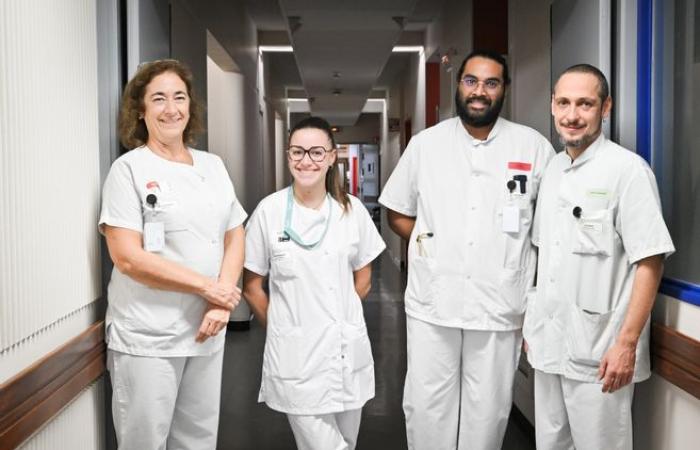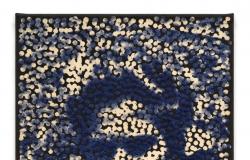
Hoped for since 2015, a palliative care unit has been operational since September, at Bourges hospital. Its six beds accommodate complex cases, not just people at the end of their lives. In the Cher, a world palliative care day is planned for Tuesday October 15.
Lying in an armchair, a blue blanket on her legs, Muriel speaks using the keypad of her phone. Multiple sclerosis freezes his body and face. With her thin voice, she can answer “yes” or “no” to a simple question. For a more detailed response, she texts on her screen. And speak with his eyes.
Breast cancer: testimonies of three women facing the disease
Muriel is 57 years old. For a week, she has been hospitalized in the new palliative care unit at Jacques-Cœur hospital in Bourges. A hospital where she worked in June 2023, when the illness broke out. “I was a neurology nurse,” she wrote. Hospitalization does him good. “Everyone is nice here. »
The “diseases that cannot be cured” service
Long desired, the palliative care unit (USP) at Jacques-Cœur hospital opened in September. “I have been leading the project since 2015. Despite the good will here, there have always been obstacles to its opening,” explains Veronica Rigondet, doctor and head of the hospital’s palliative care activity. At the beginning, there was a shortage of doctors, and after covid, nurses. »
What unlocked everything were the debates on the law on the end of life
. One of the components of the project concerns palliative care and pain management. “The parliamentarians interviewed the players in the sector,” continues Veronica Rigondet. This showed that palliative care was little known, even among caregivers, and that access to it was unequal across the country. » In March 2024, there was a shortage of palliative care units in twenty-one French departments. “The State has provided funds. The establishment seized them. »
In France, in addition to USP beds, there are 5,566 “identified palliative care beds”, reserved for less complex situations. In Cher, in addition to the six USP beds, there are around fifty “identified palliative care beds”.
In Bourges, the project included the opening of a unit with ten beds plus one. There are ultimately six, “because a colleague is on maternity leave. We would not have been able to operate the new USP, in addition to the mobile team and the departmental support team that already existed.”
Contrary to popular belief, we do not necessarily die in palliative care.
“Like resuscitation, we welcome the most complex cases. We come here to take a step forward,” explains Veronica Rigondet. empty
(empty)
The complexities are vast. They can be respiratory, or linked to neurodegenerative pathologies (Parkinson’s, Alzheimer’s, multiple sclerosis). “There are also those whose organs are failing, their heart, a kidney… Sometimes, the family has no other choice, as there is a lack of doctors, physiotherapists, nurses in the region… »
The former geriatrician and her team must also deal with ethical complexity. “That is to say, patients requesting euthanasia. First, we wonder why. There may be pain, anguish, fear of death. Sometimes there is the feeling of being a burden to one’s family and to society. »
Suffering from Charcot’s disease and defender of assisted suicide, Loïc Résibois died after deep sedation
In this “diseases that cannot be cured” department, we think collegially. “We evaluate the benefit-risk balance of a treatment. As in geriatrics, we do global assessments. It is up to our unit to adapt to the patient and not the other way around. » “Of course, it’s an ideal,” adds intern Stan Coupan. But we get closer to it here than in an average hospital department. »
The palliative care unit gives priority to external patients, referred by general practitioners, hospitalization at home (HAD), oncologists, the geriatric day hospital, the oncology day hospital, etc. “The aim is to avoid a stretcher in the emergency room,” emphasizes Veronica Rigondet.
Once a month, the USP team takes stock with a psychologist:
This is to see more clearly in our care. See the human, not just the coat, explains Matthieu Ganem, caregiver.
The staff who work in palliative care are volunteers. “We don’t impose,” points out Veronica Rigondet. Otherwise, it’s failure. You need interpersonal skills and empathy. Otherwise, we are mistreated. »
A united team
Nurse Ana Rodriguez adds that we must be ready to adapt to many different pathologies: “The questioning is permanent, we must be united. » “And here, everyone brings their skills, the hierarchy is less visible than elsewhere in the hospital,” explains Matthieu Ganem. This puts the patient at the center, and not their pathology. »
Located in a wing of the Berruyer hospital, the palliative care unit hopes to move into dedicated premises within a year.
Project abandoned after the dissolution of the National Assembly on June 9.
FREE ENTRANCE.
Le Cher takes part in World Palliative Care Day, October 15, in Guillaume-de-Varye. From 11 a.m. to 4 p.m., information stands open to all, in the hall of the private hospital in Saint-Doulchard. At 8 p.m., at the Saint-Doulchard medical-social center, conference by Ségolène Perruchio, doctor, vice-president of the French society of support and palliative care.
[email protected]





